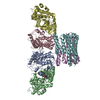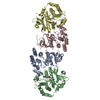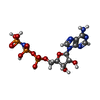[English] 日本語
 Yorodumi
Yorodumi- PDB-9axy: Crystal structure of BRAF/MEK complex with NST-628 and inactive RAF -
+ Open data
Open data
- Basic information
Basic information
| Entry | Database: PDB / ID: 9axy | ||||||
|---|---|---|---|---|---|---|---|
| Title | Crystal structure of BRAF/MEK complex with NST-628 and inactive RAF | ||||||
 Components Components |
| ||||||
 Keywords Keywords | TRANSFERASE / Inhibitor / complex / SIGNALING PROTEIN | ||||||
| Function / homology |  Function and homology information Function and homology informationepithelial cell proliferation involved in lung morphogenesis / positive regulation of endodermal cell differentiation / negative regulation of homotypic cell-cell adhesion / negative regulation of hypoxia-induced intrinsic apoptotic signaling pathway / regulation of vascular associated smooth muscle contraction / positive regulation of axon regeneration / CD4-positive, alpha-beta T cell differentiation / mitogen-activated protein kinase kinase / CD4-positive or CD8-positive, alpha-beta T cell lineage commitment / Golgi inheritance ...epithelial cell proliferation involved in lung morphogenesis / positive regulation of endodermal cell differentiation / negative regulation of homotypic cell-cell adhesion / negative regulation of hypoxia-induced intrinsic apoptotic signaling pathway / regulation of vascular associated smooth muscle contraction / positive regulation of axon regeneration / CD4-positive, alpha-beta T cell differentiation / mitogen-activated protein kinase kinase / CD4-positive or CD8-positive, alpha-beta T cell lineage commitment / Golgi inheritance / placenta blood vessel development / negative regulation of synaptic vesicle exocytosis / MAP-kinase scaffold activity / positive regulation of muscle contraction / regulation of axon regeneration / cerebellar cortex formation / Signalling to p38 via RIT and RIN / labyrinthine layer development / melanosome transport / head morphogenesis / ARMS-mediated activation / type B pancreatic cell proliferation / endothelial cell apoptotic process / myeloid progenitor cell differentiation / Signaling by MAP2K mutants / SHOC2 M1731 mutant abolishes MRAS complex function / Gain-of-function MRAS complexes activate RAF signaling / positive regulation of D-glucose transmembrane transport / negative regulation of fibroblast migration / vesicle transport along microtubule / establishment of protein localization to membrane / positive regulation of axonogenesis / positive regulation of Ras protein signal transduction / regulation of Golgi inheritance / mitogen-activated protein kinase kinase kinase binding / central nervous system neuron differentiation / regulation of T cell differentiation / triglyceride homeostasis / trachea formation / Negative feedback regulation of MAPK pathway / regulation of early endosome to late endosome transport / regulation of stress-activated MAPK cascade / Frs2-mediated activation / stress fiber assembly / MAPK3 (ERK1) activation / ERBB2-ERBB3 signaling pathway / regulation of neurotransmitter receptor localization to postsynaptic specialization membrane / face development / endodermal cell differentiation / MAP kinase kinase activity / Bergmann glial cell differentiation / positive regulation of ATP biosynthetic process / thyroid gland development / Uptake and function of anthrax toxins / synaptic vesicle exocytosis / positive regulation of protein serine/threonine kinase activity / somatic stem cell population maintenance / protein kinase activator activity / positive regulation of peptidyl-serine phosphorylation / MAP kinase kinase kinase activity / postsynaptic modulation of chemical synaptic transmission / negative regulation of endothelial cell apoptotic process / Schwann cell development / response to axon injury / keratinocyte differentiation / positive regulation of stress fiber assembly / neuron projection morphogenesis / ERK1 and ERK2 cascade / myelination / positive regulation of substrate adhesion-dependent cell spreading / protein serine/threonine/tyrosine kinase activity / positive regulation of autophagy / substrate adhesion-dependent cell spreading / dendrite cytoplasm / insulin-like growth factor receptor signaling pathway / cellular response to calcium ion / response to glucocorticoid / MAP3K8 (TPL2)-dependent MAPK1/3 activation / thymus development / animal organ morphogenesis / protein serine/threonine kinase activator activity / Signal transduction by L1 / cell motility / positive regulation of transcription elongation by RNA polymerase II / Spry regulation of FGF signaling / RAF activation / Signaling by high-kinase activity BRAF mutants / MAP2K and MAPK activation / visual learning / small GTPase binding / centriolar satellite / cellular response to xenobiotic stimulus / epidermal growth factor receptor signaling pathway / long-term synaptic potentiation / neuron differentiation / chemotaxis / Negative regulation of MAPK pathway / Signaling by RAF1 mutants / Signaling by moderate kinase activity BRAF mutants / Paradoxical activation of RAF signaling by kinase inactive BRAF Similarity search - Function | ||||||
| Biological species |  Homo sapiens (human) Homo sapiens (human) | ||||||
| Method |  X-RAY DIFFRACTION / X-RAY DIFFRACTION /  SYNCHROTRON / SYNCHROTRON /  MOLECULAR REPLACEMENT / Resolution: 3.6 Å MOLECULAR REPLACEMENT / Resolution: 3.6 Å | ||||||
 Authors Authors | Quade, B. / Huang, X. | ||||||
| Funding support | 1items
| ||||||
 Citation Citation |  Journal: Cancer Discov / Year: 2024 Journal: Cancer Discov / Year: 2024Title: The Pan-RAF-MEK Nondegrading Molecular Glue NST-628 Is a Potent and Brain-Penetrant Inhibitor of the RAS-MAPK Pathway with Activity across Diverse RAS- and RAF-Driven Cancers. Authors: Meagan B Ryan / Bradley Quade / Natasha Schenk / Zhong Fang / Marshall Zingg / Steven E Cohen / Brooke M Swalm / Chun Li / Ayşegül Özen / Chaoyang Ye / Maria Stella Ritorto / Xin Huang / ...Authors: Meagan B Ryan / Bradley Quade / Natasha Schenk / Zhong Fang / Marshall Zingg / Steven E Cohen / Brooke M Swalm / Chun Li / Ayşegül Özen / Chaoyang Ye / Maria Stella Ritorto / Xin Huang / Arvin C Dar / Yongxin Han / Klaus P Hoeflich / Michael Hale / Margit Hagel /  Abstract: Alterations in the RAS-MAPK signaling cascade are common across multiple solid tumor types and are a driver for many cancers. NST-628 is a potent pan-RAF-MEK molecular glue that prevents the ...Alterations in the RAS-MAPK signaling cascade are common across multiple solid tumor types and are a driver for many cancers. NST-628 is a potent pan-RAF-MEK molecular glue that prevents the phosphorylation and activation of MEK by RAF, overcoming the limitations of traditional RAS-MAPK inhibitors and leading to deep durable inhibition of the pathway. Cellular, biochemical, and structural analyses of RAF-MEK complexes show that NST-628 engages all isoforms of RAF and prevents the formation of BRAF-CRAF heterodimers, a differentiated mechanism from all current RAF inhibitors. With a potent and durable inhibition of the RAF-MEK signaling complex as well as high intrinsic permeability into the brain, NST-628 demonstrates broad efficacy in cellular and patient-derived tumor models harboring diverse MAPK pathway alterations, including orthotopic intracranial models. Given its functional and pharmacokinetic mechanisms that are differentiated from previous therapies, NST-628 is positioned to make an impact clinically in areas of unmet patient need. Significance: This study introduces NST-628, a molecular glue having differentiated mechanism and drug-like properties. NST-628 treatment leads to broad efficacy with high tolerability and central nervous system activity across multiple RAS- and RAF-driven tumor models. NST-628 has the potential to provide transformative clinical benefits as both monotherapy and vertical combination anchor. | ||||||
| History |
|
- Structure visualization
Structure visualization
| Structure viewer | Molecule:  Molmil Molmil Jmol/JSmol Jmol/JSmol |
|---|
- Downloads & links
Downloads & links
- Download
Download
| PDBx/mmCIF format |  9axy.cif.gz 9axy.cif.gz | 303.7 KB | Display |  PDBx/mmCIF format PDBx/mmCIF format |
|---|---|---|---|---|
| PDB format |  pdb9axy.ent.gz pdb9axy.ent.gz | Display |  PDB format PDB format | |
| PDBx/mmJSON format |  9axy.json.gz 9axy.json.gz | Tree view |  PDBx/mmJSON format PDBx/mmJSON format | |
| Others |  Other downloads Other downloads |
-Validation report
| Summary document |  9axy_validation.pdf.gz 9axy_validation.pdf.gz | 1.2 MB | Display |  wwPDB validaton report wwPDB validaton report |
|---|---|---|---|---|
| Full document |  9axy_full_validation.pdf.gz 9axy_full_validation.pdf.gz | 1.2 MB | Display | |
| Data in XML |  9axy_validation.xml.gz 9axy_validation.xml.gz | 22.7 KB | Display | |
| Data in CIF |  9axy_validation.cif.gz 9axy_validation.cif.gz | 30.1 KB | Display | |
| Arichive directory |  https://data.pdbj.org/pub/pdb/validation_reports/ax/9axy https://data.pdbj.org/pub/pdb/validation_reports/ax/9axy ftp://data.pdbj.org/pub/pdb/validation_reports/ax/9axy ftp://data.pdbj.org/pub/pdb/validation_reports/ax/9axy | HTTPS FTP |
-Related structure data
| Related structure data |  9axaC  9axcC  9axhC  9axmC  9axxC  9ay7C  9ayaC C: citing same article ( |
|---|---|
| Similar structure data | Similarity search - Function & homology  F&H Search F&H Search |
- Links
Links
- Assembly
Assembly
| Deposited unit | 
| ||||||||||||
|---|---|---|---|---|---|---|---|---|---|---|---|---|---|
| 1 |
| ||||||||||||
| Unit cell |
|
- Components
Components
| #1: Protein | Mass: 31826.807 Da / Num. of mol.: 1 Source method: isolated from a genetically manipulated source Source: (gene. exp.)  Homo sapiens (human) / Gene: BRAF, BRAF1, RAFB1 / Production host: Homo sapiens (human) / Gene: BRAF, BRAF1, RAFB1 / Production host:  References: UniProt: P15056, non-specific serine/threonine protein kinase | ||||||
|---|---|---|---|---|---|---|---|
| #2: Protein | Mass: 43518.988 Da / Num. of mol.: 1 Source method: isolated from a genetically manipulated source Source: (gene. exp.)  Homo sapiens (human) / Gene: MAP2K1, MEK1, PRKMK1 / Production host: Homo sapiens (human) / Gene: MAP2K1, MEK1, PRKMK1 / Production host:  References: UniProt: Q02750, mitogen-activated protein kinase kinase | ||||||
| #3: Chemical | | #4: Chemical | #5: Chemical | ChemComp-A1AHE / | Mass: 488.464 Da / Num. of mol.: 1 / Source method: obtained synthetically / Formula: C22H18F2N4O5S / Feature type: SUBJECT OF INVESTIGATION Has ligand of interest | Y | |
-Experimental details
-Experiment
| Experiment | Method:  X-RAY DIFFRACTION / Number of used crystals: 1 X-RAY DIFFRACTION / Number of used crystals: 1 |
|---|
- Sample preparation
Sample preparation
| Crystal | Density Matthews: 3.4 Å3/Da / Density % sol: 63.82 % |
|---|---|
| Crystal grow | Temperature: 291 K / Method: vapor diffusion, hanging drop / pH: 8 Details: 0.2 M Lithium chloride, 0.1 M TRIS pH 8, 20% w/v PEG 8000 |
-Data collection
| Diffraction | Mean temperature: 100 K / Serial crystal experiment: N |
|---|---|
| Diffraction source | Source:  SYNCHROTRON / Site: SYNCHROTRON / Site:  SSRF SSRF  / Beamline: BL02U1 / Wavelength: 0.97918 Å / Beamline: BL02U1 / Wavelength: 0.97918 Å |
| Detector | Type: DECTRIS EIGER2 S 9M / Detector: PIXEL / Date: Dec 16, 2022 |
| Radiation | Protocol: SINGLE WAVELENGTH / Monochromatic (M) / Laue (L): M / Scattering type: x-ray |
| Radiation wavelength | Wavelength: 0.97918 Å / Relative weight: 1 |
| Reflection | Resolution: 3.6→53.34 Å / Num. obs: 12215 / % possible obs: 99.5 % / Redundancy: 12.6 % / Biso Wilson estimate: 85.16 Å2 / Rmerge(I) obs: 0.257 / Net I/σ(I): 8.5 |
| Reflection shell | Resolution: 3.6→3.94 Å / Rmerge(I) obs: 0.918 / Num. unique obs: 2810 |
- Processing
Processing
| Software |
| ||||||||||||||||||||||||||||||||||||||||
|---|---|---|---|---|---|---|---|---|---|---|---|---|---|---|---|---|---|---|---|---|---|---|---|---|---|---|---|---|---|---|---|---|---|---|---|---|---|---|---|---|---|
| Refinement | Method to determine structure:  MOLECULAR REPLACEMENT / Resolution: 3.6→47.21 Å / SU ML: 0.3801 / Cross valid method: FREE R-VALUE / σ(F): 1.36 / Phase error: 22.2411 MOLECULAR REPLACEMENT / Resolution: 3.6→47.21 Å / SU ML: 0.3801 / Cross valid method: FREE R-VALUE / σ(F): 1.36 / Phase error: 22.2411 Stereochemistry target values: GeoStd + Monomer Library + CDL v1.2
| ||||||||||||||||||||||||||||||||||||||||
| Solvent computation | Shrinkage radii: 0.9 Å / VDW probe radii: 1.1 Å / Solvent model: FLAT BULK SOLVENT MODEL | ||||||||||||||||||||||||||||||||||||||||
| Displacement parameters | Biso mean: 84.54 Å2 | ||||||||||||||||||||||||||||||||||||||||
| Refinement step | Cycle: LAST / Resolution: 3.6→47.21 Å
| ||||||||||||||||||||||||||||||||||||||||
| Refine LS restraints |
| ||||||||||||||||||||||||||||||||||||||||
| LS refinement shell |
| ||||||||||||||||||||||||||||||||||||||||
| Refinement TLS params. | Method: refined / Origin x: -52.3876393731 Å / Origin y: 22.7845663519 Å / Origin z: 4.09307028667 Å
| ||||||||||||||||||||||||||||||||||||||||
| Refinement TLS group | Selection details: all |
 Movie
Movie Controller
Controller




 PDBj
PDBj






















